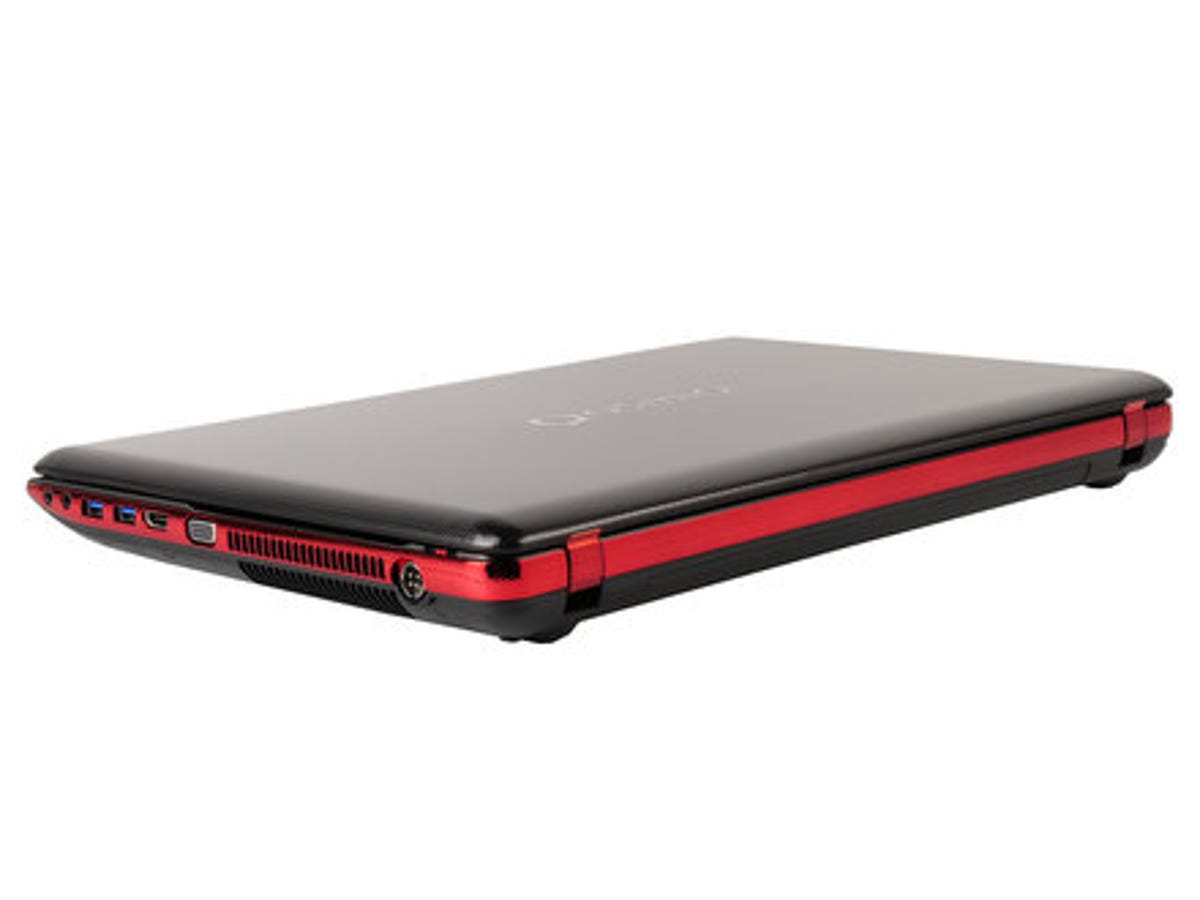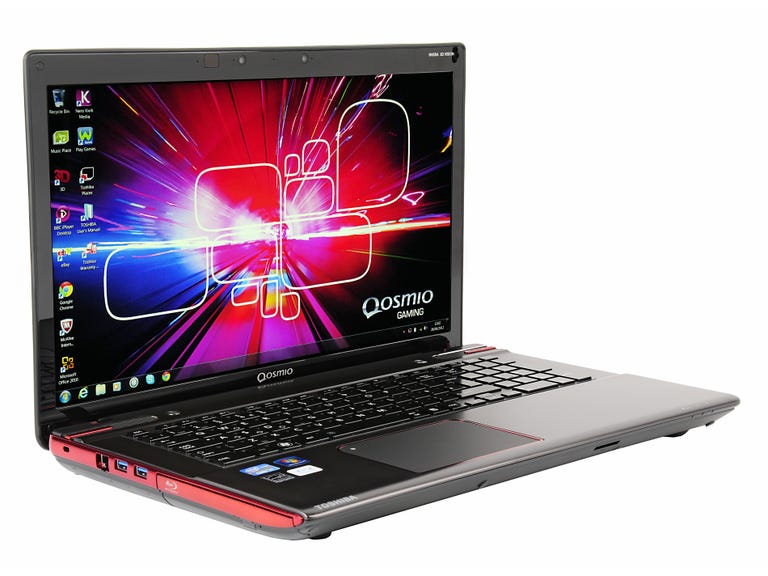 Why You Can Trust CNET
Why You Can Trust CNET Toshiba Qosmio X870-11Q review: Toshiba Qosmio X870-11Q
The Toshiba Qosmio X870-11Q might be huge and aggressive looking but it packs some seriously powerful components for gaming and media use.
Toshiba's Qosmio X770 was an excellent laptop stuffed with potent nuggets of silicon that were easily capable of tackling demanding tasks and video games.
The Good
The Bad
The Bottom Line
Toshiba has given it a refresh for 2012 with the X870-11Q, which packs the latest Intel Ivy Bridge chips and a spicy Nvidia GeForce GT670M graphics card, letting you play the latest games at the highest settings without much trouble.
My review model came with an Intel Core i7 processor, a whopping 16GB of RAM and will set you back £1,700.
Design and build quality
Like most of Toshiba's Qosmio range, the X870 is a chunky beast. It has to be, of course, as it's housing a gargantuan 17.3-inch screen. That should immediately extinguish any thoughts that this is the sort of laptop you'll be taking away on office trips or quickly whipping out on a train to send emails.

It measures 418mm wide and 272mm deep so it's not a machine that will sit comfortably in a shoulder bag. Find a suitable spot in your house and leave it there. Make sure your table's got good legs on it to support the not inconsiderable 3.4kg weight.
The whole chassis is wrapped in a metal/plastic alloy that's been given a deep steel-grey colour which, together with the red accents around the edge and under the lid, add up to a rather aggressive look. If you want a subtle-looking laptop for the office, this isn't going to be for you. But if angry styling gets you in the mood for some serious fragging, it's likely to be right up your proverbial.
It feels generally well put together, with only a touch of flex when you push down on the lid and the wrist rest. It clearly isn't something you're going to be carrying all over the place, where it could get knocked and bashed, but it's still good to know it could probably survive a tumble to the floor from the sofa.
The massive size and weight helps it sit firmly on your desk, making it comfortable for working on those marketing reports for hours on end, or more likely, playing Battlefield 3 into the early hours.
Around the edges you'll find four USB 3.0 ports, HDMI out, VGA out, headphone and microphone jacks, an Ethernet port and a Blu-ray drive. There's also a 1TB hard disk drive inside for storing movies and games and a fast 128GB solid state drive that should keep start-up times speedy.
Keyboard and trackpad
Under the lid you'll find what seems to be Toshiba's standard laptop keyboard -- it's the same one it dumps on nearly all of its machines. That's sadly not a positive thing as the plain square keys and unappealing font detract somewhat from its style. The look of the keyboard might not be the biggest of issues, but when you're paying £1,700 for a laptop, you'd be right to be a little picky about aesthetics.
The keys offer a fairly standard typing experience. If I was really nitpicking, I'd say they're perhaps a little too easy to press, which led to some inaccuracies at first, but I quickly got used to the feel and I've certainly used worse keyboards.
The trackpad is a much better experience all round. For starters, it's huge, and doesn't have separate buttons, meaning all the space can be used for sliding your finger around. It's also pretty responsive, which makes quick cursor work in web browsing that much easier.
Of course, if you plan on doing a lot of browsing and office work on this thing, you'd still find your hands thanking you for a proper external mouse, but it's adequate. It has a pleasant matte texture to it that lets your finger glide across without any awkward sticking.
Screen
The screen is arguably one of the shining lights of the X870, not least because it's so big. It measures 17.3 inches corner to corner, making it a good size for movies and games.
It's also packing a Full HD resolution of 1,920x1,080 pixels so you can enjoy shiny new shoot-em-ups or Blu-ray discs at the optimum quality. If the 17-inch display doesn't quite cut it, you can always output your video to a TV using the HDMI port. But 17 inches is still a great size for catching up on the latest flicks in your bedroom or tackling gaming on the sofa.
Toshiba has a good track record of producing high-quality screens for its laptops and that's still the case with the X870. It's bold, bright and has great black levels, giving video and photos a 'pop' that movie buffs will particularly appreciate. I loaded up my Blu-ray copy of Art of Flight (which, as I've said before, is the best piece of film-making ever achieved by man), and it displayed extremely well, with crisp snow, bold colours and great contrast.
It's also using Nvidia's 3D Vision technology to let you watch 3D movies using the glasses provided. You'll of course need 3D Blu-ray discs for this feature to work and games that support 3D -- first-person shooters are always a good choice for this.
The 3D experience is the same as you'd expect on any of Toshiba's 3D line-up. It does the job of showing off that extra dimension once you've set up and calibrated the software, but it's still possible to detect double images and you'll need to remain fairly square to the screen to get the best effect. 3D TVs still do a better job so you probably shouldn't treat this feature as the main reason to buy it -- it's best to view it as a handy extra.
Performance
If you've just dropped more than one and a half grand on a new laptop, you're really going to want serious power. Thankfully, Toshiba has stuffed the X870 with the latest kit, making it poised and ready to tackle whatever you throw at it.
Inside, you'll find an Intel Core i7-3610QM processor clocked at 2.3GHz, paired with a very generous 16GB of RAM. The chip is Intel's most recent model, known as Ivy Bridge, which promises better built-in graphics performance, with increased energy efficiency over its Sandy Bridge predecessor. I've already seen these new processors providing excellent power in other machines so I was looking forward to taking it for a spin.
To see how it stacks up against the competition, I booted the Geekbench benchmark test and was given a score of 13,538. That's extremely good and puts it easily above the X770, which achieved a lesser (but still good) 11,334. It also managed to nearly double the score offered by the Toshiba L875, although it costs twice the price, so you should expect a much better performance.
During general use, I found it to be extremely competent. Programs and windows opened without delay and I didn't notice any kind of lag or slowdown when I loaded numerous web browser windows, each running many tabs. I ran Adobe Photoshop Lightroom 4 and found it was very capable of editing high-resolution images without hiccups. If you're after a laptop to handle graphics work, it's certainly worth considering.
One of the let-downs is the enormous amount of extra software Toshiba has loaded on. There's a bunch of programs and cheap games that I highly doubt will ever be used and will sit there slowing down your start-up times, stealing slices of your processing power in the background.
You could argue it's nice to have extra games pre-loaded, but it seems unlikely anyone paying £1,700 for a gaming laptop is going to care about playing Polar Bowler. I recommend uninstalling as much as you can before downloading Steam and playing some real games.
Speaking of which, the X870 is also packing an Nvidia GeForce GTX 670M graphics card, which is just itching to tear into the latest, shiniest games. I booted up my favourite rally racer Dirt 3, set the resolution to the 1080p maximum, whacked the detail settings on high and sent my car out into the Finnish hills.
The X870 maintained an average frame rate of around 75 frames per second, which is extremely good. That resulted in gameplay that looked incredibly smooth and totally free of lag.
It was mostly able to cope with the more demanding Metro 2033 too. Again, the game was played at full resolution and at high detail settings, using DirectX 11, and maintained an average frame rate of about 25fps. This is about the minimum I'd consider playable. Gameplay was mostly smooth, with only the odd drop when the action became intense.
If you knock the settings down slightly and maybe use an older version of DirectX (something you can change in the settings menu), it would be possible to achieve better frame rates with smoother gameplay and less lag.
Battery life
As it's such an enormous machine, you're unlikely to be carrying it too far, so battery life for on-the-go use isn't much of an issue. Still, it's good to know it could keep going if you carried it from the plug in your bedroom to the socket next to the sofa.
Running my heavy use battery test, it kept going for around 56 minutes. That's really not great but it's about what I'd expect from a laptop like this. You can get better performance if you don't tax it too hard, but you shouldn't consider taking it anywhere without quick access to a power socket.
Conclusion
The Toshiba Qosmio X870-11Q might have the sort of angry styling that excites teenage boys but it's packing extremely potent components under the steel-grey hood.
With its latest Intel processor, a hearty serving of RAM and the powerful dedicated graphics card, the X870 is capable of tackling any office task, some photo and video editing and the latest gaming titles -- just don't try and carry it around for too long.


